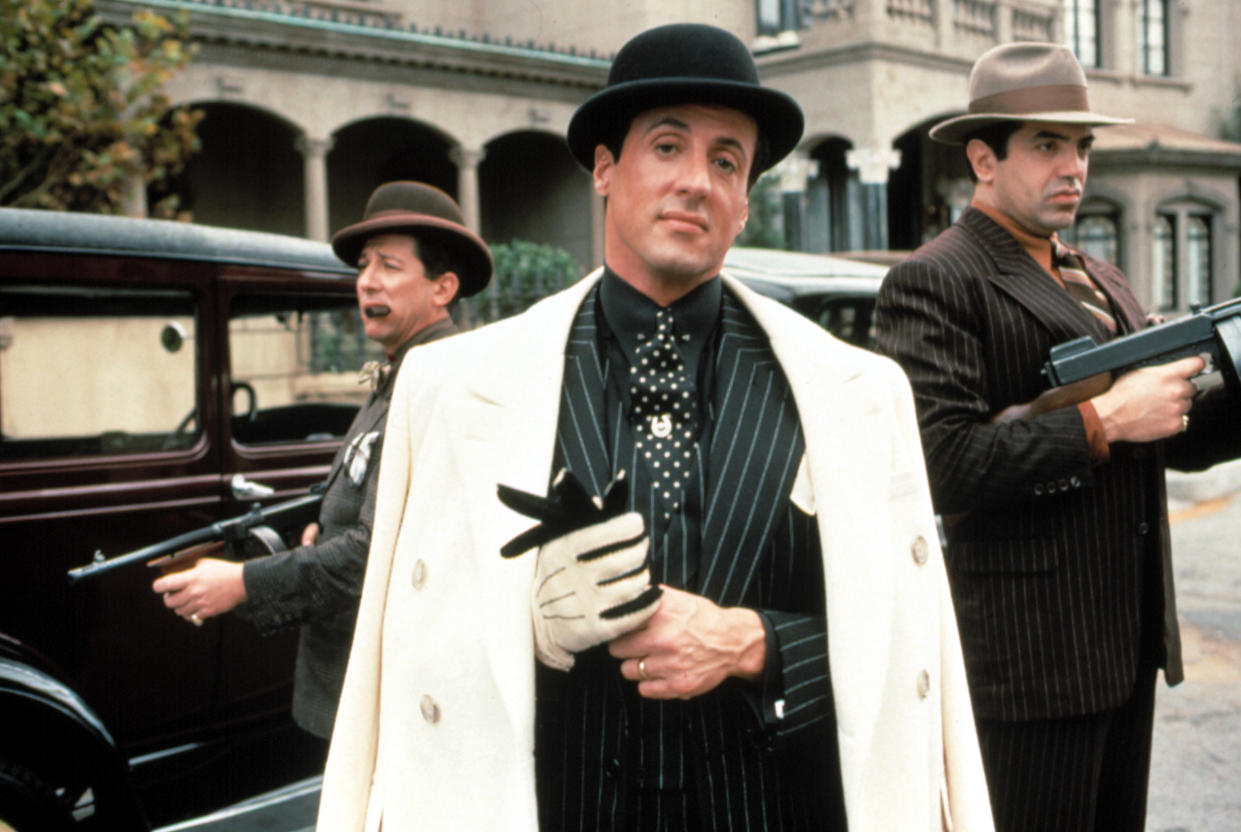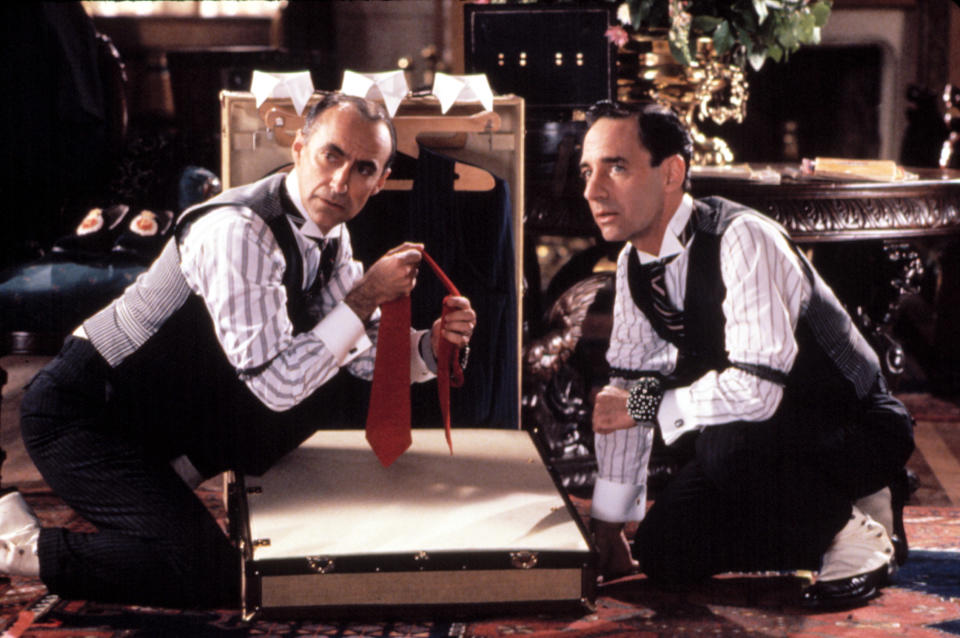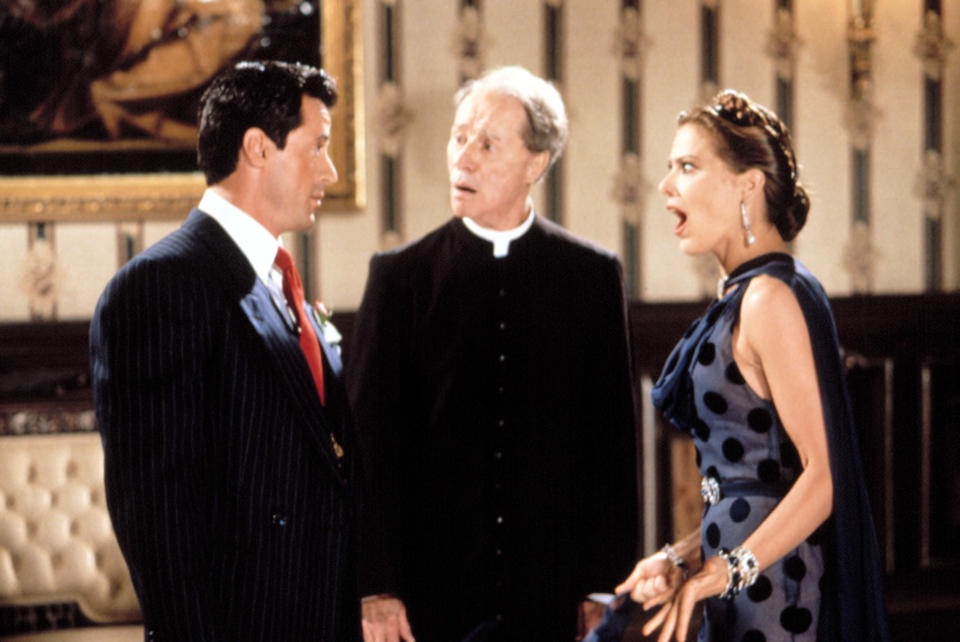Sylvester Stallone Gave the Performance of His Career in 1991 Farce ‘Oscar’ (Yes, Really)

- Oops!Something went wrong.Please try again later.
- Oops!Something went wrong.Please try again later.
In the new Netflix documentary “Sly,” Sylvester Stallone reflects on a time in his career when he felt he lost his way — basically, a rare period during which he wasn’t making “Rocky” or “Rambo” movies. To hear Stallone tell it, taking a break from his two signature roles was misguided folly, corrected only when he wrote and directed “Rocky Balboa” in 2006 and followed it up with a new “Rambo” two years later. (If you want to get a sense of Stallone’s devotion to franchises, consider the fact that, of the eight movies he directed, only the first and last were non-sequels; he even wrote and directed a sequel to somebody else’s iconic hit when he helmed “Staying Alive” at John Travolta’s behest.)
“Sly” director Thom Zimny seems to more or less accept this version of film history, and if one’s only measure of value is box office grosses the idea has some validity; there’s no arguing with the fact that whenever Stallone strayed too far from his franchises (after “Rocky” and “Rambo” he managed to find one more with the “Expendables” series), audiences tended to stay away. Zimny doesn’t even need to spend much time on this section of Stallone’s career to make the point — he simply devotes a few minutes to the 1991 gangster farce “Oscar” and uses it as shorthand for cinematic disaster.
More from IndieWire
There’s only one problem: “Oscar” is a great movie, and Stallone gives one of his best performances in it. When “Oscar” was released in the spring of 1991 it garnered mostly negative reviews (though Gene Siskel and Roger Ebert, the most popular critics in America at the time, both liked it) and box office returns were disappointing. Yet this seems to have had more to do with Stallone defying expectations than with the movie’s actual pleasures, which are considerable and so obvious that reading contemporary reviews right after viewing it can be a surreal experience.

“Oscar” originated as a French play (and subsequent filmed adaptation) that gave director John Landis the kind of sturdy underlying structure he liked; its complicated interplay of misunderstandings and switched bags full of valuables (or not) has echoes of Landis’ best film, “Trading Places,” as well as the classic screwball comedies of the ’30s and ’40s and Peter Bogdanovich’s tribute to them, “What’s Up, Doc?” Landis handed the template over to screenwriting partners Michael Barrie and Jim Mulholland, gag writers for Johnny Carson who also scripted “Amazon Women on the Moon” for Landis and were the scribes behind Danny DeVito’s hilarious directorial debut “The Ratings Game.”
In their hands, the contemporary French farce became a very American period piece about a Depression-era gangster (Stallone) suffering through an escalating series of calamities on the day that he has decided to go legit. Barrie and Mulholland’s script is a structural marvel, as they introduce characters and situations at a breakneck pace without losing the audience no matter how many complications pile on top of one another. There are dozens of major characters in “Oscar” who orbit around Stallone’s mobster, and there’s a mathematical precision to the way that Barrie and Mulholland connect them in unpredictable ways, giving an impression of chaos that resolves in the film’s final scenes with breathtaking clarity — when the anarchic film reveals the careful design that has been lurking underneath all along, it’s as satisfying in its own way as Rocky going the distance with Apollo Creed in the original “Rocky.”
A great comic symphony like the one Barrie and Mulholland designed needs a great conductor, and in Landis “Oscar” found its Leonard Bernstein. Though Landis had made several terrific comedies before “Oscar” — “Animal House,” “The Blues Brothers,” “Trading Places,” and “Coming to America” among them — “Oscar” was exceptionally well suited to his skill set and background. Like Martin Scorsese, Quentin Tarantino, and Joe Dante, Landis is a director deeply rooted in film history, with a particular love for the comedies of the classical studio system that created the tradition to which “Oscar” belongs. Keeping the audience acclimated amidst constantly accelerating comic chaos is not easy, but Landis learned from the best in his study of Ernst Lubitsch, Preston Sturges, and other masters of cinematic farce; his attention to geography and space in “Oscar” is almost Kurosawa-esque in its dynamism and clarity, and the fact that barely anyone seemed to notice it at the time is part of the point — you don’t notice Landis’ craftsmanship as you’re watching the movie because its purpose is to remove every obstacle between you and a nonstop barrage of belly laughs.

One way in which Landis achieves his clarity and concision when it comes to the visual storytelling is by marshaling every resource of the 1990s studio system to his ends the same way that his ancestors did the more assembly line-oriented studio system of their era. “Oscar” is not only a film that takes place in the 1930s but one made like a film from the 1930s, with extensive use of sets and studio backlots to create carefully planned camera moves and blocking made possible by complete control over the shooting conditions. The comedy in “Oscar” depends not only on a meticulous mapping out of the Stallone character’s lavish home but the streets and buildings around it and how they’re related to each other, and Landis expertly ties the various lines of action together in elegant crane shots and long takes that swiftly establish who and where the characters are.
To a certain degree, Landis was lucky in that his resources on “Oscar” were among the least limited he ever worked with; Stallone was still considered a big star at the time, and Landis quickly learned that having him on board meant the studio wasn’t as concerned with the budget. The money flowed even more freely after a fire on the Universal lot destroyed many of the “Oscar” sets and costumes and the production had to relocate to Florida; when Landis got there he found that anything he wanted was made available to him on an extravagant level, and when he asked the line producer he found out why — it was all insurance money, not the studio’s. In any case, the expansive budget gave Landis one of his most lavish productions and provided a visual feast for the audience in the form of the movie’s richly detailed production design and costumes.
Ironically given the fact that his participation got the movie green-lit and gave Landis his abundant budget, Stallone ended up being the reason “Oscar” flopped. The writing was on the wall at test screenings where audiences who came to see a movie starring the guy who played John Rambo were confused — one of them even wrote on a response card that they were waiting for Stallone to take his shirt off and kill people. Stallone’s audience wasn’t interested in seeing him in a sophisticated farce, and the audience for a sophisticated farce assumed that Stallone’s participation meant “Oscar” was not for them. This power of suggestion seems to have made its way to reviewers, who saw the film as a dumb comedy even though a cursory glance at any random five minutes makes it obvious that there’s thought and style behind the movie.

The fact is that Stallone was never better before or after “Oscar,” giving a performance of technical dexterity that shows a side of the actor the less verbally oriented “Rocky” and “Rambo” movies never could. For while “Oscar” is a visual triumph it’s also a triumph of language, with the kind of rapid-fire dialogue one finds in the best Howard Hawks or Sturges comedies. Stallone is more than up to the task, with nimble comic timing that rewards repeat viewings; there’s such a flurry of activity whizzing around him at all times that sometimes the subtleties of his delivery are easy to miss. (They were certainly easy to miss for the myopic critics who reviewed the movie.)
It should also be noted that Stallone is surrounded by one of the great comedic ensembles of all time, and he more than holds his own at the center of it. Once Landis had Stallone the studio seems to have given him carte blanche on the rest of the casting, and he filled “Oscar” with a combination of old pros (Kirk Douglas, Yvonne de Carlo, Eddie Bracken, Don Ameche), new discoveries (Marisa Tomei, Chazz Palminteri), comic masters (Harry Shearer, Tim Curry), and reliable members of his stock company (Peter Riegert, Mark Metcalf). It’s a deep bench of talent, and the amazing thing about “Oscar” is that everyone seems to have gotten the delicate tone — the heightened pitch of the film is not one that was typical of its period (another reason the movie was criminally underrated), yet everybody from Tomei to Ameche plays each note on the comedic scale flawlessly. Stallone is the anchor that keeps the whole thing from spinning out of control, which is why it’s a shame that he and the makers of “Sly” see “Oscar” as a mistake rather than what it actually is: a brief glimpse of a side of Stallone that it would have been nice to see more of, if only “Oscar” was the hit that it deserved to be.
Best of IndieWire
Sign up for Indiewire's Newsletter. For the latest news, follow us on Facebook, Twitter, and Instagram.

